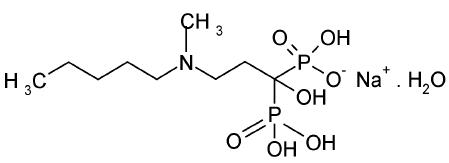Crystal Structure of prior invention in prior application was misunderstood, and JPO board of appeal’s decision was reversed.
IP Court Case Summary:2013(Gyo-Ke) 10285:
<Invention>
The title of the invention at issue is “Ibandronate Polymorph A”. Claim-1 is “A crystalline polymorph of 3-(N-methyl-N’-pentyl) amino-1-hydroxypropane-1, 1-diphosphonic acid, monosodium salt monohydrate (Ibandronate) which is characterized by an X-ray powder diffraction pattern having characteristic peaks expressed in angle 2-theta;
Angle 2-theta ± 0.2[deg.]
10.2[deg.]
11.5[deg.]
15.7[deg.]
19.4[deg.]
26.3[deg.].”
In the description, the chemical formula of Ibandronate was shown as follows;

3-(N-methyl-N’-pentyl) amino-1-hydroxypropane-1, 1-diphosphonic acid, monosodium salt monohydrate
<Prior Application>
The invention in prior application was related to the crystalline polymorph of Ibandronate. The description disclosed the data of Thermos Gravimetric Analysis (TGA)on the crystalline polymorph of Ibandronate. Moreover, it disclosed an X-ray powder diffraction pattern on the crystalline polymorph of Ibandronate.
<Comparison>
The claimed invention at issue was related to the crystalline polymorph of Ibandronate, which is identical to the invention in prior application.
However, the claimed invention at issue is “Monohydrate”, which is not clear in the description of prior application. Moreover, X-ray powder diffraction pattern on the crystalline polymorph of Ibandronate is different between the claimed invention at issue and the invention in prior application.
<JPO Board of Appeal>
JPO board of appeal understood that the different between the claimed invention at issue and the invention in prior application is not substantial. Then, JPO board of appeal decided that the claimed invention at issue is identical to the invention in prior application.
<IP High Court>
IP High Court finally reversed JPO board of appeal’s decision, and decided that the claimed invention at issue is NOT identical to the invention in prior application. The reasons are as follows;
– According to the data of Thermos Gravimetric Analysis (TGA)on the crystalline polymorph of Ibandronate in prior application, Ibandronate in prior application might be “Monohydrate”. However, it is not clear if the loss of water under TGA is related to hydrate or adhesive water. Therefore, it is not clear if the claimed invention at issue is identical to the invention in prior application.
– X-ray powder diffraction pattern on the crystalline polymorph of Ibandronate is different between the claimed invention at issue and the invention in prior application. Specifically, 10.2[deg.] and 11.5[deg.] are not shown in X-ray powder diffraction pattern in prior application. Therefore, the claimed invention at issue is NOT identical to the invention in prior application.
<Comments>
This IP High Court decision is important as the judicial decision on the patentability of the invention related to the crystalline polymorph. Under this decision, the data of Thermos Gravimetric Analysis (TGA)and X-ray powder diffraction pattern are important to explain the structure of crystalline polymorph. However, those data should be enough clear to precisely explain the difference between the claimed invention at issue and the invention in prior application.
This must be one of the cases by the JPO that finding of the cited invention was forcedly approximated to the claimed invention in finding the cited invention from the cited document. Applicants should often check if JPO’s practice on finding of the cited invention is correct.
<Notes> Case Study on Inventive Step (JPO)
In most lawsuits in which inventive step was an issue and the judgment made by the Japan Patent Office (JPO) was held to be incorrect, it was judged that finding of the cited invention was forcedly approximated to the claimed invention in finding the cited invention from the cited document.
http://www.ip.courts.go.jp/app/files/hanrei_jp/800/084800_hanrei.pdf